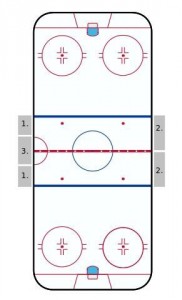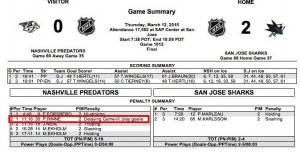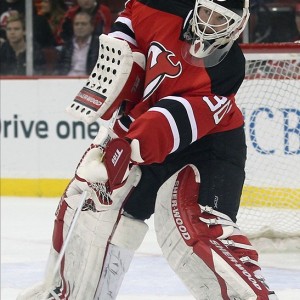I’ll start by saying that we’re lucky to be fans of a league that takes risks. The NHL is a league that never seems fully satisfied. They’re always tweaking rules and instituting new facets of the game in a quest to appeal to a greater audience. Because some of their new ideas fall flat we sometimes take for granted the innovations that actually improve the game. What I’m saying is I’d rather the league try new things and fail than to remain content with the way things are.
The greatest example of the league’s non-complacency came after the 2005 lockout. The league instituted a plethora of new rules in an effort to maximize offense and to increase the flow of the game. The two-line pass was taken away to encourage long stretch passes and to limit stoppages in play. Goaltenders’ gear was trimmed a bit to give shooters more room to shoot at. And, perhaps the most evident, they instituted the shootout following the overtime period to ensure that there’s a winner every night.
The league is constantly trying to come up with a way to best reflect all of the stardom, skill, and excitement they have to offer.
But sometimes they flat-out swing and miss.
Some of their ideas go the way of the dodo after a few years of dissatisfactory results. For example, the league once tried to increase the area behind the net (nicknamed “Gretzky’s Office”) to try to create more offensive creativity. That experiment only lasted a few years before moving the nets back. Additionally, 3-on-3 overtime (which may also be a mistake) is being introduced in order to limit the effects of the aforementioned shootout, which many grew to detest.
But there exists one rule in particular that has brought absolutely nothing to the table and has made no discernible positive impact on the sport of hockey:
The trapezoid.
The Trapezoid’s Inception

The trapezoid was one of the rules brought into play after the 2005 lockout. The design is a simple trapezoid behind the net, starting on the goal line six feet from each goal post extending to twenty feet wide along the boards (depicted on the right). The goaltenders are only allowed to play the puck inside of the trapezoid when the puck goes behind the net. The idea was that this would limit the goaltender’s ability to retrieve the puck for their team and would give the attacking team a greater chance at winning possession of the puck deep in their offensive zone.
The rule singled out goalies like Martin Brodeur and Marty Turco who were perhaps the two most skilled puck handlers. The rule was even dubbed the “Martin Brodeur Rule” because of the goalie who it affected the most.
At the time, nobody was really sure if the rule would actually create more offense or not. It seemed like such a minor, unnecessary tweak and caused a good amount of criticism.
Why the Rule is Absolute Garbage
It’s not hyperbole to state that this rule is an unmitigated disaster. I can cite several issues with the rule and each one has its merit.
1) It’s Confusing
The ice surface in the NHL is laughable. It looks like a toddler dropped a box of crayons on a white oval leaving different-coloured streaks, circles, and dots in multiple places. New fans often find it hard to understand the many line violations that exist in the league and it could even serve as a barrier of entry for newcomers. A curious new fan would indubitably have trouble making sense of why that trapezoid is crucial for gameplay.
Sure, that could be a minor issue with the trapezoid. But a real issue is that it’s a difficult rule for the referees to interpret.
A couple of years ago, referee Kerry Fraser wrote a small piece on TSN about how he one time incorrectly called Ryan Miller for Delay of Game for playing the puck outside the trapezoid. Miller believed that he never actually touched the puck in the illegal area and Fraser was “fooled” by it.

Looking through a ton of game sheets from the past 5 years (dating back to the 2010-2011 season), I counted just about 32 Delay of Game* calls for goalies playing the puck outside the trapezoid. That’s only 6 times per season. This rule, which appears nonessential to begin with, is a headache for referees, fans, and goalies and it only gets called 6 times a season. It’s mind-boggling.
*It’s difficult to find the data for how many of these penalties have been called. With no penalty database (to my knowledge) I had to go to game sheets for individual games where the trapezoid penalty is listed as “Delay of Game-Ill. play goalie”. However, there were some cases where the penalty was just listed as “Delay of Game” with no explanation. Doing some research through the game sheets combined with some investigating on Twitter, I counted 32 times the infraction was called in the past 5 seasons. I imagine the figure could be off by just a few in either direction but not by enough to make an actual difference in the point.
2) It Puts Defencemen in Danger
This is an oft-quoted issue that many people have with the rule. Because goalies can’t go out and play the puck when it gets dumped in, the defencemen have to skate back to get it themselves. This makes them vulnerable as their backs are turned to the ice while forecheckers are bearing down on them.
That’s what the rule was made for. The league wanted the defencemen to have to be put in this position so the offensive team can simply rub them off the puck almost immediately. However, this leads to many brutal boarding penalties that all could have been avoided if the goalie played the puck himself.
Sure, hybrid icing has really limited these kinds of hits over the past few years, but removing the trapezoid could rid us of these heinous hits for good.
3) Some Goalies Are Really Good at Playing the Puck (While Some Aren’t)

The slew of rule changes in 2005 were meant to increase the offense and excitement in the league. What the league did not consider was how goaltenders playing the puck can actually create offense. Some goalies, like Brodeur, acted as a third defenceman in his own zone. One team would dump the puck in deep and Brodeur would hustle to the corner and fire the puck the other way starting a perfect counterattack. Puck handling was a skill that some goaltenders worked their life perfecting and this skill was blatantly taken away from them.
“You can’t be happy, taking away something I’ve worked on all my life to do,” Brodeur said in an interview with the New York Times back in 2005. “It’s just the fact that the N.H.L. wants to show the talent to their fans and stuff. And I think this is not doing it. I think it goes the other way around. It goes taking away a talent from guys.”
There are still some very good puck handling goalies in the league today. Guys like Ben Bishop and Mike Smith are very good sending the puck up ice. But their impact on the game using that asset is diminished because of the trapezoid and we are cheated from an exciting part of the game.
https://twitter.com/wcranor/status/600024903031611392
While we lose some offense because good goalies can’t play the puck as often, we also miss out on a ton offense because bad goalies aren’t forced to play the puck more often.
There are some goalies that are flat-out awful when it comes to playing the puck.
Here Jonathan Quick gives away a goal in the Cup Final a few years back.
Alex Auld, what are you doing?
Stop it, Cam Talbot.
Roberto Luongo. C’mon man.
I think you guys get the point.
But these bad puck-playing goalies don’t only give up gimmes for the offense but they also help create more powerplays. As I mentioned earlier, there were roughly 32 penalties on goalies for playing the puck outside of the trapezoid in the past 5 seasons. In that same span, I counted 63 Delay of Game penalties on goaltenders for shooting the puck over the glass. So the NHL is trying to prevent goalies from playing the puck, threatening a penalty if they do. But when goalies do actually play the puck, they commit more penalties than the trapezoid does in the first place.
So without the trapezoid, goalies would have to play the puck more often and that would certainly lead to more goals being scored, either by masterful stretch passes to lead a counterattack or by embarrassing gaffes by the lesser skilled netminders.
4) Negative Effect on Style of Play
Perhaps the most fundamental issue with the trapezoid is that it encourages boring hockey. The whole concept was that teams would be able to dump the puck into the zone and wreak havoc with their forecheck. However, we’re past the point of knowing the importance of puck possession and we’d rather see teams carry the puck into the zone than just dumping it into the corner. We have so many skilled players in the league and to have a rule that promotes the almost-prehistoric dump-and-chase style seems counterproductive to what the league is trying to accomplish. The best way to promote the game is to promote the stars and dumping the puck into the zone limits the creativity of the budding talent that the league has to offer.
We’re fortunate that the NHL is always trying to better themselves. But an important part of that strategy is to reevaluate the changes you’ve made and figure out which ideas have worked and which ones have not. The league even widened the trapezoid a couple of years ago, maybe a sign that they know the writing’s on the wall and the trapezoid isn’t a necessity.
The idea of the trapezoid may have had some merit at the time of its inception but it’s clear at this juncture that it’s time to put an end to the trapezoid era.